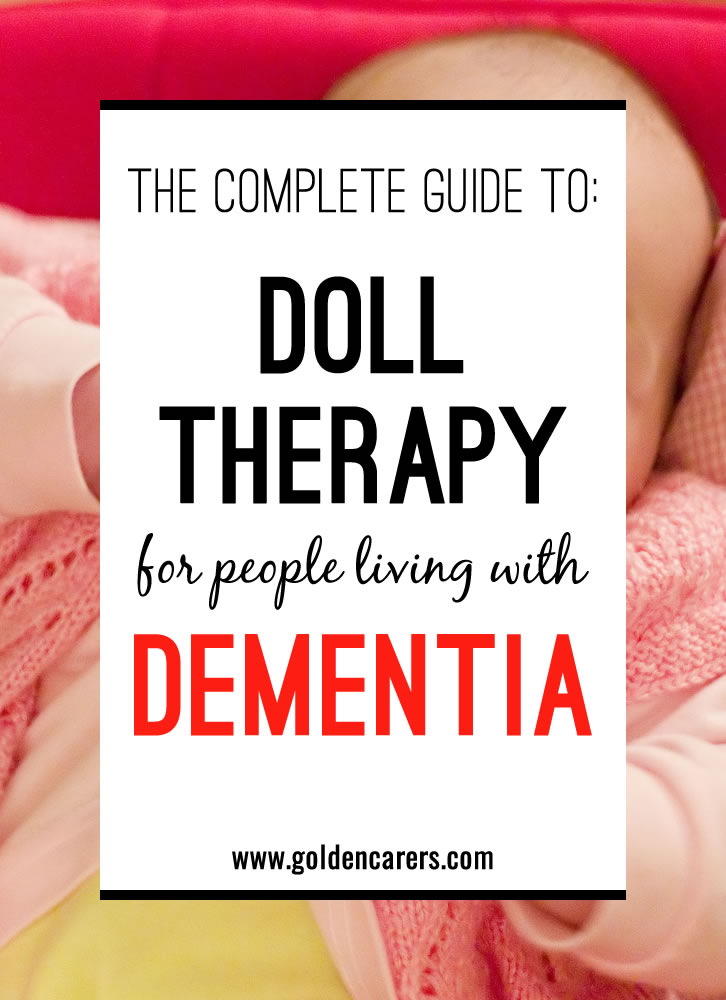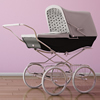
Related Activities
Comments Post a Comment


Susan  19th Oct 2021
Activity Director
19th Oct 2021
Activity Director
 19th Oct 2021
Activity Director
19th Oct 2021
Activity Director
Hi Di
Thank you for your input and suggestion
Thank you for your input and suggestion
di
17th Oct 2021
My mother was so much calmer when she was holding and interacting with her doll. Seeing this, as a Girl Scout leader I used to go to local bazaars and buy old dolls making sure they had no parts that could come off and were soft. I would run them through the washer to make sure they were clean and dry them thoroughly. We would take them with us when we went caroling at local nursing homes and give them out to residents to wanted one. Of course we would get permission from those in charge. It would put a smile on a lot of faces.


Susan  20th Feb 2020
Activity Director
20th Feb 2020
Activity Director
 20th Feb 2020
Activity Director
20th Feb 2020
Activity Director
Hi Cheryl and others
This comment may help you
https://www.goldencarers.com/comments/3027/
I would think about getting multiple baby dolls if they are of interest to your residents which it seems to be that they are
Just like with real babies they need to rest so this can be a way for you to have the residents put them away
You could say that you have to practice something now which may be what they need to do
Just like with other items that are popular you need to explain to them about taking turns
Maybe you can set a clock and say OK now it’s somebody else’s turn on now it’s time to do it with something else
This comment may help you
https://www.goldencarers.com/comments/3027/
I would think about getting multiple baby dolls if they are of interest to your residents which it seems to be that they are
Just like with real babies they need to rest so this can be a way for you to have the residents put them away
You could say that you have to practice something now which may be what they need to do
Just like with other items that are popular you need to explain to them about taking turns
Maybe you can set a clock and say OK now it’s somebody else’s turn on now it’s time to do it with something else

Diana  16th Oct 2018
Home Typist/carer
16th Oct 2018
Home Typist/carer
 16th Oct 2018
Home Typist/carer
16th Oct 2018
Home Typist/carer
My mum is well known for taking her ‘baby’ every where with her. Marvellous best purchase made for her
Talita  21st Oct 2018
21st Oct 2018
 21st Oct 2018
21st Oct 2018
This is lovely to hear Diana, I'm sure it is a wonderful comfort to her!
Melody  31st Jul 2018
OTA
31st Jul 2018
OTA
 31st Jul 2018
OTA
31st Jul 2018
OTA
One resident in particular is a joy to watch her love for a very life like baby. She is very softly spoken so it’s a little difficult to know for sure she thinks the baby is real. Her smile never leaves her face as she gently touches its cheeks and feet. I think she would have been such a loving Mum to her kids
Talita  5th Aug 2018
5th Aug 2018
 5th Aug 2018
5th Aug 2018
How lovely Melody, the baby is probably a great source of comfort to her.
Gabriel Daniel
7th Dec 2017
I’m doing a college project on treatments for dementia, and am hoping to find an author for this writing along with the date published.
Talita  10th Dec 2017
10th Dec 2017
 10th Dec 2017
10th Dec 2017
Hi Gabriel, this article was written by Solange Kindermann and published on the 29/09/2014
Cheers!
Cheers!
Deborah Babbit
7th Jul 2017
I worked as a nurses aid be for nursing school in 1970, and a sweet granny always carried a baby doll around. She was always calm.
I'd suggest a black-skin baby as well, even if your patients are all Caucasian. Some Caucasian mothers have long loved little African children. Multiple races of babies should be there.
So very glad this is growing in practice! It fits in nicely in the games and toys in dementia units.
I'd suggest a black-skin baby as well, even if your patients are all Caucasian. Some Caucasian mothers have long loved little African children. Multiple races of babies should be there.
So very glad this is growing in practice! It fits in nicely in the games and toys in dementia units.
Ana granja
15th Mar 2017
Hello. I'm starting a therapy session for the dolls, but I need some advice. What should be the duration of the session? And how often? once a week? Once a month
Thank you for your sharing.
Social greetings
Ana granja
Thank you for your sharing.
Social greetings
Ana granja
Solange  15th Mar 2017
Diversional Therapist
15th Mar 2017
Diversional Therapist
 15th Mar 2017
Diversional Therapist
15th Mar 2017
Diversional Therapist
Hi Ana, it depends on your set up. You may use a corner of the recreation area to keep the dolls. In this corner you should have comfortable chairs for clients to sit and nurse the babies. Also have a changing table, baby clothes and other baby related items. Usually the clients just enjoy holding the dolls. This activity can be daily for as long as there is interest.
Christine
17th Feb 2017
Just wanted to know they trying baby therapy on mum what concerns me that my mum thinks the baby is dead as my niece baby died can anyone please let me know if anyone has that kind of reaction thanks
Solange  20th Feb 2017
Diversional Therapist
20th Feb 2017
Diversional Therapist
 20th Feb 2017
Diversional Therapist
20th Feb 2017
Diversional Therapist
Hi Christine, a phycologist would be better able to advise you. My instinct tells me that if your mother thinks the baby is dead she may be grieving and suffering again for the baby. If that is the case, I would suggest to stop baby therapy and try again at a later stage (a few weeks).
Lola omanhia
14th Nov 2016
Thanks Solange
Lola omanhia
1st Nov 2016
Hi! I found the doll therapy so interesting! I want to use it in the dementia area where I work but I don't know how to start it... Could you help me? What do I have to do? Should I tell my patient she have to take care? Or I give it like a present? Thanks!
Solange  1st Nov 2016
Diversional Therapist
1st Nov 2016
Diversional Therapist
 1st Nov 2016
Diversional Therapist
1st Nov 2016
Diversional Therapist
Hi Lola, you may show the baby doll to clients, and wait for their reaction. Usually they want to hold it. Otherwise just lay the baby doll on a crib or couch and let clients ‘find’ it. Be aware that clients’ family sometimes disapprove of it, despite its benefits. Good luck!
Tracey  4th Aug 2016
Lifestyle Assistant
4th Aug 2016
Lifestyle Assistant
 4th Aug 2016
Lifestyle Assistant
4th Aug 2016
Lifestyle Assistant
How would you go about assessing if a resident is going to be suited for 'doll therapy'? Would you maybe bring the baby in for a 1:1 with the resident and see how they feel about the baby?
Suzana  23rd Jul 2016
Divisional Therapist
23rd Jul 2016
Divisional Therapist
 23rd Jul 2016
Divisional Therapist
23rd Jul 2016
Divisional Therapist
I think doll therapy is great in our facility we have a resident constantly looking for a baby we gave her a doll and has been more settled
Julie  25th Jun 2015
Diversional Therapist
25th Jun 2015
Diversional Therapist
 25th Jun 2015
Diversional Therapist
25th Jun 2015
Diversional Therapist
Hi, we are looking to purchase a good baby doll for doll/baby therapy but are finding it difficult to find out where! The dementia shop seems to be out of stock & we really want to get the right kind! Can anyone help us?
Irma  2nd Jun 2015
2nd Jun 2015
 2nd Jun 2015
2nd Jun 2015
Is there anyone who has an assessment form for doll therapy?
Cheryl-Lee  19th Feb 2020
Recreational Activities Officers
19th Feb 2020
Recreational Activities Officers
 19th Feb 2020
Recreational Activities Officers
19th Feb 2020
Recreational Activities Officers
I am just starting to introduce "Doll Therapy" but now thinking I do like the name "Nurture Therapy". I have just got given a cradle today which I'm hoping to put into our quite room to assist with morning tea etc so the baby doesnt get given food or drink and get dirty.
I would love some ideas on possessiveness behaviours and allowing the baby to have sleeps so that daily routines toileting ,showering, meals can be continued.
As well as the person having a break so the baby isnt held for long periods of time so the person can interact with other activities and not becoming isolated with just the baby and the person. I have seen some positive beautiful outcomes but also more behaviours from the baby not letting others near them.
Also has anyone got any documentation/forms to assist with this form of therapy apart from the normal observations of the person. Im wanting to grab hold of any info possible to share with the rest of my colleagues.
I would love some ideas on possessiveness behaviours and allowing the baby to have sleeps so that daily routines toileting ,showering, meals can be continued.
As well as the person having a break so the baby isnt held for long periods of time so the person can interact with other activities and not becoming isolated with just the baby and the person. I have seen some positive beautiful outcomes but also more behaviours from the baby not letting others near them.
Also has anyone got any documentation/forms to assist with this form of therapy apart from the normal observations of the person. Im wanting to grab hold of any info possible to share with the rest of my colleagues.
dorothy  8th Feb 2015
diversional therapist
8th Feb 2015
diversional therapist
 8th Feb 2015
diversional therapist
8th Feb 2015
diversional therapist
i use doll therapy in our facility firstly i researched for evidence of why this works for some and not other people then i printed off a simple to the point article for staff and found that staff in the beginning ,was a barrier to it working effectively but over time they are now all seeing the benefits .
Then i purchased life like dolls and a crib and placed the dolls all wrapped up in there and waited for a response within an hour of setting up the display a lady saw the babies and went over and she asked me if she could look after this one , she instantly called the baby Thomas and cradled him , over the period of the day her whole outlook changed and as the days went on her need for medication decreased as she no longer was banging on the doors to go home because her children needed her . Staff now see the benefits and her family are just so pleased to see her happy and content. So to wrap it up you cannot really asses someone for doll therapy they will be drawn to it if the need is there then you have to put in place a management plan so the person doesn't get overwhelmed by the caring they need some down time , e.g. meal times , rest time , bed time .I hope my story helps you decide if you will give it a try if it meets one persons needs than you have done something fantastic .
Then i purchased life like dolls and a crib and placed the dolls all wrapped up in there and waited for a response within an hour of setting up the display a lady saw the babies and went over and she asked me if she could look after this one , she instantly called the baby Thomas and cradled him , over the period of the day her whole outlook changed and as the days went on her need for medication decreased as she no longer was banging on the doors to go home because her children needed her . Staff now see the benefits and her family are just so pleased to see her happy and content. So to wrap it up you cannot really asses someone for doll therapy they will be drawn to it if the need is there then you have to put in place a management plan so the person doesn't get overwhelmed by the caring they need some down time , e.g. meal times , rest time , bed time .I hope my story helps you decide if you will give it a try if it meets one persons needs than you have done something fantastic .
Sue  24th Nov 2014
aged day care co-ordinator
24th Nov 2014
aged day care co-ordinator
 24th Nov 2014
aged day care co-ordinator
24th Nov 2014
aged day care co-ordinator
sue 24-11-14
Nurture therapy is a wonderful way to encourage caring interaction in a person, male or female.
careful observation of the individual will determine suitability, family and friends can give the staff valuable insight as to the suitability.
There are many and varied interactive "babies" to choose from.
Nurture therapy is a wonderful way to encourage caring interaction in a person, male or female.
careful observation of the individual will determine suitability, family and friends can give the staff valuable insight as to the suitability.
There are many and varied interactive "babies" to choose from.
Trish  4th Oct 2014
Diversional Therapist
4th Oct 2014
Diversional Therapist
 4th Oct 2014
Diversional Therapist
4th Oct 2014
Diversional Therapist
I found doll therapy to be very beneficial in the recent Dementia
area I worked in. There can however be a lot of friction between
residents as they fight over whose doll it is. Best to have many
on hand. A handy tip, if you need to take the doll away from the resident
for e.g. its morning tea time, say that the doll is going to the nursery
for a sleep.
area I worked in. There can however be a lot of friction between
residents as they fight over whose doll it is. Best to have many
on hand. A handy tip, if you need to take the doll away from the resident
for e.g. its morning tea time, say that the doll is going to the nursery
for a sleep.
Karen  30th Sep 2014
Lifestyle assistant
30th Sep 2014
Lifestyle assistant
 30th Sep 2014
Lifestyle assistant
30th Sep 2014
Lifestyle assistant
During a singing session I often pass the lifelike baby doll around the group, the residents singing to the "baby". It creates a positive atmosphere and feelings of contentment. What can be more natural than the desire to hold and cuddle a baby, which brings back so many memories for residents. No point analyzing the "therapy", just enjoy the moment.
Sharon  30th Sep 2014
RAO
30th Sep 2014
RAO
 30th Sep 2014
RAO
30th Sep 2014
RAO
Agreed Nurture therapy is a much better name. We use this therapy at our facility but is not for everyone. For some of our residents it is a very beneficial activity, calming the resident and actually giving that resident some enjoyment, minimising behaviours, so it's a win win as far as I am concerned.
cindy
30th Sep 2014
yes great article we already have introduced doll therapy don't forget to get a signed document were family agree for there loved one to have.
DMAS in Tasmania do supply lifelike dolls at a price.
cindy
DMAS in Tasmania do supply lifelike dolls at a price.
cindy
Pam  30th Sep 2014
Lifestyle + Leisure Coordinator
30th Sep 2014
Lifestyle + Leisure Coordinator
 30th Sep 2014
Lifestyle + Leisure Coordinator
30th Sep 2014
Lifestyle + Leisure Coordinator
....Nature Therapy or Nurture Therapy? Call it what suits the culture in which it is used. This (as for any therapy) work with, & for, some dementias but not for other types (or different resident mix). If staff are accepting and non judgemental (as they should be) then others will be too... It is great for residents to have feelings and emotions of any type!
Dot  30th Sep 2014
Diversional Therapist
30th Sep 2014
Diversional Therapist
 30th Sep 2014
Diversional Therapist
30th Sep 2014
Diversional Therapist
Used to love doll therapy until a resident, and those near her, became very distressed by the "dead" baby because it did not move. Now have interactive kitten, the small one. When this kitten has not moved for some time, a cuddle/stoke will cause it to move.
So as always we need to monitor.
So as always we need to monitor.
Claire  30th Sep 2014
Recreation Therapist
30th Sep 2014
Recreation Therapist
 30th Sep 2014
Recreation Therapist
30th Sep 2014
Recreation Therapist
I use doll therapy at my facility, one man who has since passed away used to sit and cuddle the doll in the evenings, it stopped him roaming the hallways, he thought it was one of his grandchildren. He would rock and sing to her, I found doll therapy to be very successful with him, it curbed his behaviors. Nurture therapy is a great term, but i haven't had any negative feedback from other staff or residents families at this stage, so will continue with our 'Doll therapy'.
Debra  30th Sep 2014
Volunteer
30th Sep 2014
Volunteer
 30th Sep 2014
Volunteer
30th Sep 2014
Volunteer
I have always been an advocate of Doll Therapy however have also experienced the down side which was usually caused by individual staff who did not understand the therapeutic benefit and sabotaged the experience for the resident. Totally agree you need to very carefully pick your residents and monitor closely to gauge reactions. I have been told off soundly when saying how beautiful 'she' is when it is a 'boy'. Also love the term 'Nuture Therapy' which removes the stigma of childlike. I have also witnessed this therapy work extraordinarily well with certain men with behavioural issues, (more around looking after/nursing than caring tasks)
jacquie  30th Sep 2014
activity coordinator
30th Sep 2014
activity coordinator
 30th Sep 2014
activity coordinator
30th Sep 2014
activity coordinator
l use dolls and am introducing other baby itens to our resources. l think its a valid therapy as it promotes conversation and socialising especially among the female residents and evenif they are not interested in the dolls we talk about the knitted clothes and some enjoy folding and washing them
Jacqueline  30th Sep 2014
Diversional therapy team leader
30th Sep 2014
Diversional therapy team leader
 30th Sep 2014
Diversional therapy team leader
30th Sep 2014
Diversional therapy team leader
I am still sitting on the fence with doll therapy. I have seen it work very successfully for some residents but I have also seen it back fire and become another behaviour issue. I think as Diversional therapists we need to ensure that we have assessed the person correctly for this therapy, ensure that staff and family are on board with it before we try it. At the end of the day if you have a calm content resident then it was the right thing to do. I like the term Nuture therapy rather that Doll therapy.

Cathy  29th Sep 2014
Lifestyle Coordinator/ DT
29th Sep 2014
Lifestyle Coordinator/ DT
 29th Sep 2014
Lifestyle Coordinator/ DT
29th Sep 2014
Lifestyle Coordinator/ DT
At our facility we use a "reborn" doll which is life-like for 1x1 or group therapy use and the usual kind of baby doll for our dementia unit were residents wander and or hold the dolls all the time. We call it "Nurture therapy" on our programming due to the negative connotations of "doll therapy".


 5 Aphasia Activities for Senior Care
5 Aphasia Activities for Senior Care
 Sifting and Sorting Bins for Dementia Care
Sifting and Sorting Bins for Dementia Care
 13 Ways to Include Math In Your Activity Calendar
13 Ways to Include Math In Your Activity Calendar
 Down Memory Lane with Autograph Books
Down Memory Lane with Autograph Books




Behavior can definitely be an issue
I like the term expression also